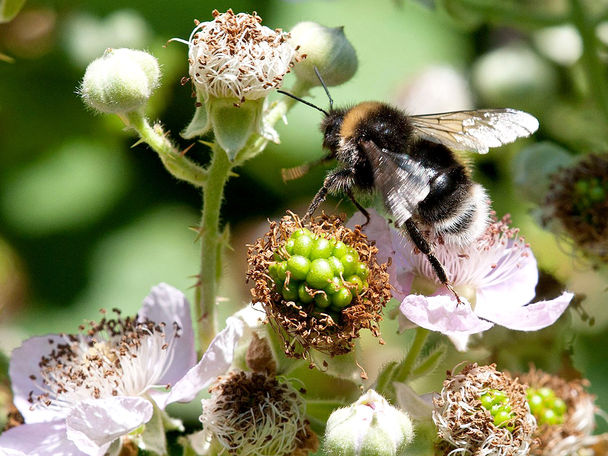Bee enthusiasts beat the bushes Sunday to see if the colony of rare insects is still active, and biologists are planning conservation efforts.
Seattle Times science reporter

Will Peterman snapped the “Bigfoot” shot July 7: a blurred image of a creature so rare that many experts feared it had been wiped out in Washington.
But even out of focus, there was no mistaking the feature that distinguishes the Western bumblebee from other species in the Northwest.
“White butt,” Peterman explained.
On Tuesday, he returned to the tiny park in Brier, northeast of Seattle, where he took the first picture. This time, he captured a sharp portrait of a fat, fuzzy, white-bottomed Bombus occidentalisforaging in a blackberry hedge.
“There was some shouting,” Peterman said, recalling his excitement. On Sunday, he and a group of biologists and bee enthusiasts from the University of Washington made a more systematic sweep through the park and nearby areas.
The group didn’t locate the colony’s nest, but they did spot a solitary queen.
“We got scads more pictures,” Peterman said.
The discovery of what may be the only population of Western bumblebees in the state has raised hopes that the species could be making a comeback.
“The best case scenario is that this turns out to be a strain … that’s actually resistant to whatever it is that knocked them back in the first place,” Peterman said.
But even if the bees in Brier are just a remnant population, the find is significant, said biologist Rich Hatfield, of the Oregon-based Xerces Society for Invertebrate Conservation. “We can target conservation efforts on the ground; we can get people in that area to create habitat and to keep an eye out for them.”
Western bumblebees were once among the most common bumblebees in the Western United States. Then they began to vanish in the mid-1990s.
No one knows for sure what is killing the species, but the decline coincides with the development of commercial bumblebee-breeding programs. Breeders sold colonies to tomato farmers in the United States and Europe. (bumblebees are the only native pollinators for tomatoes.)
Scientists at the University of California, Davis hypothesize that some of the bees shipped to Europe picked up a gut parasite called Nosema bombi. When infected queens were shipped back to the U.S., the infection could have spread quickly through bumblebee populations with no native immunity.
Bees are also vulnerable to a wide range of pesticides.
“Nobody has seen Bombus occidentalis in Seattle since the mid-1990s,” said Peterman, a writer, photographer and self-described bee nerd.
The first sighting in more than a decade came from Brier resident Megan O’Donald, who spotted one of the bees in her mother’s garden last summer and reported it to the Xerces Society. The insects returned this year, and O’Donald said she saw one Sunday on a goldenrod plant.
When Peterman heard about the earlier sightings, he decided to launch a bee-hunting expedition. Using Google Earth, he identified several patches of likely habitat — mostly small parks or unmown lots. At the fourth site on his list, he got lucky.
The colony, which is located underground, may be shutting down for the season. In late summer, after the broods are raised, the bees that will develop into the next season’s queens start gorging on nectar in preparation for their winter hibernation.
“Probably all we can do now is let the bees continue their cycle and go back next spring,” said UW biology instructor Evan Sugden, who joined the hunt on Sunday.
Later this summer, the Xerces Society is launching a citizen science project that will recruit people across North America to monitor bumblebee populations, Hatfield said. A lot of attention has been paid to the decline of non-native honeybees and the mysterious killer called colony-collapse disorder, but new studies show that many bumblebees are in serious trouble, too.
Bumblebees are key pollinators for many plants because they start work early in the spring and stay on the job when the weather is too cool and cloudy for honeybees.
“If we start to lose species from our landscape,” Hatfield said, “there will be economic consequences.”
Sandi Doughton at: 206-464-2491 or sdoughton@seattletimes.com
